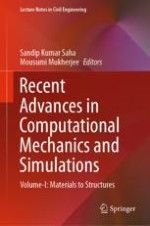2021 | OriginalPaper | Buchkapitel
Efficient Arrangement of Friction Damped Bracing System (FDBS) for Multi-storey Steel Frame
verfasst von : Saikat Bagchi, Avirup Sarkar, Ashutosh Bagchi
Erschienen in: Recent Advances in Computational Mechanics and Simulations
Verlag: Springer Singapore
Aktivieren Sie unsere intelligente Suche, um passende Fachinhalte oder Patente zu finden.
Wählen Sie Textabschnitte aus um mit Künstlicher Intelligenz passenden Patente zu finden. powered by
Markieren Sie Textabschnitte, um KI-gestützt weitere passende Inhalte zu finden. powered by
